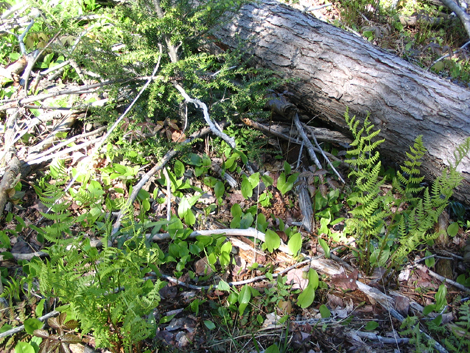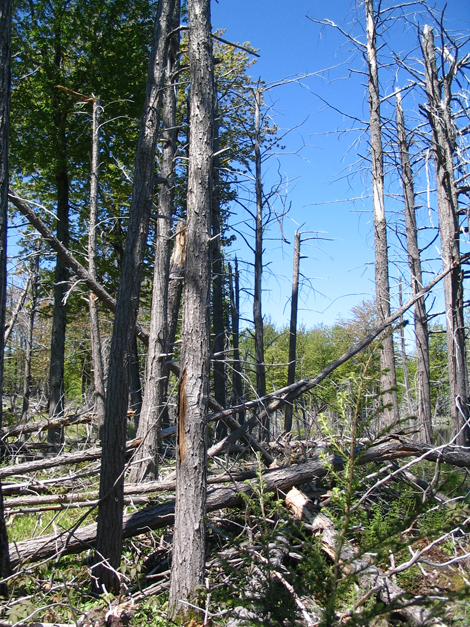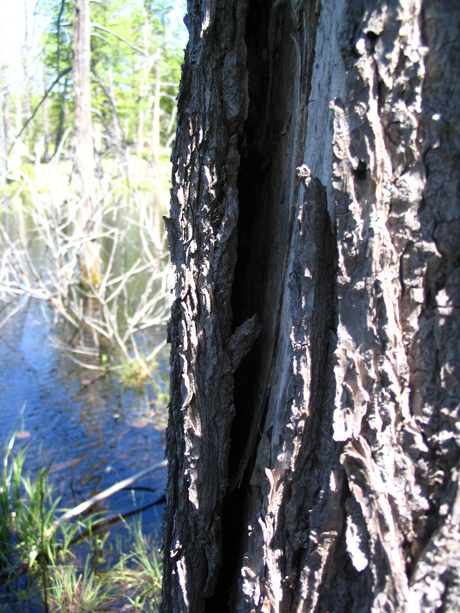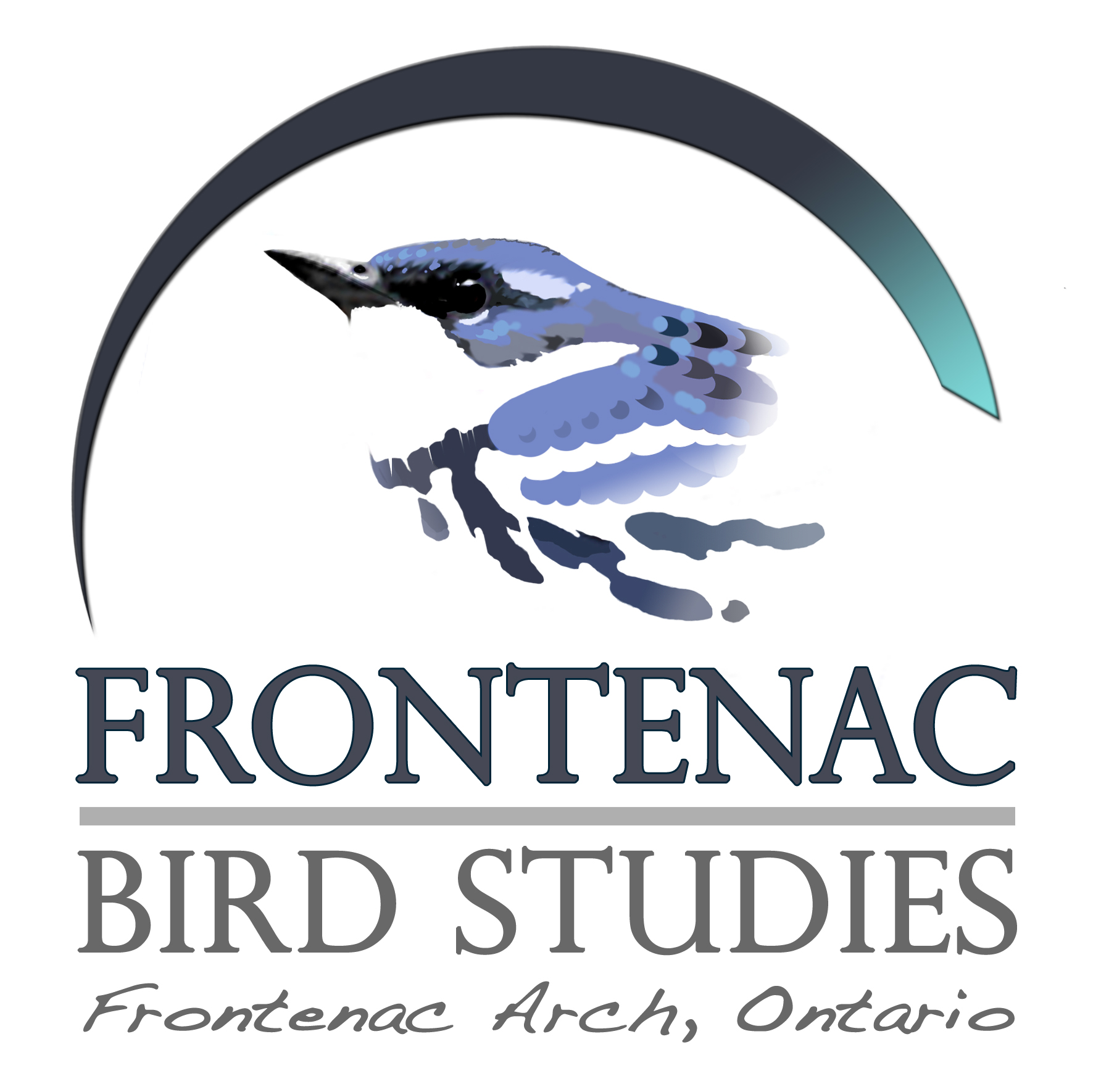
h
Returned to the Hemlock Lake site yesterday to begin searching for mistnet locations and to get a better picture of the breeding bird community for our study. The visit was considerably more comfortable than my last when black flies were particularly menacing! This latest visit was cool with very few biting insects, which afforded me a great opportunity to get to know the site a bit better. What a difference a couple of weeks can make in the late spring! The emerging foliage was substantially further along, which created a much different looking landscape. Site visits in winter and early spring gave me a solid understanding of the scale, topography and structure of the site but I knew that it wouldn’t be possible to even consider positoning net locations until the canopy and understory had matured.
Upon entry to the site, I heard Eastern Towhee, Scarlet Tanager, Nashville Warbler and a concert of voice-battling Ovenbirds. Further along to where the forest turns from deciduous to mixed-coniferous, I encountered Black-and-white, Magnolia, Black-throated Blue and Blackburnian Warblers, all species we were expecting at the site. Also of interest were at least two territories of Winter Wren, one of the most vocally adept species on the planet! I was able to record a few seconds of one of our talented males holding territory in the site along with one of the unavoidable male Ovenbirds (click play to listen).
h
Evidence of active nesting by many species included alarm calls, adults carrying nesting material and territorial disputes. I didn’t find a great number of nests but I did mark locations where a nest was suspected. I will have to return in a few days to a week to confirm presumed nest sites of Ovenbird, Black-and-white Warbler and Eastern Towhee among others.
h
 h
h
However, I did manage to find the nest of a Brown Creeper, which was discovered by patiently watching movements and behaviour of a pair in the standing dead timber at the edge of Hemlock Lake. After sitting quietly for about 45 minutes, I was finally rewarded with the observation of an adult entering a tree with nesting material. The Brown Creeper places its nest almost exclusively in dead trees, between a loose flap of bark and the trunk. They build a hammock shaped nest of sticks and fibres, which is secured to the bark with insect-egg casings and spider silk. The nest will now be monitored with the goal of deriving a nest outcome. The information will be important to our demographic studies of breeding birds in the FBS study area and will be submitted to the Ontario Nest Records Scheme and Project Nestwatch for province-wide monitoring efforts. A closer view of the nest site is provided below.
h

h
The most exciting discovery of the day led to this short video of a waterthrush carrying material to a nest in roots of an upturned tree along a clear moving stream. Northern Waterthrushes were quite vocal in the vicinity but this particular pair were all but silent except for some occassional contact calls between male and female. The calls were diagnostic of Louisiana Waterthrush but I will have to confirm identify of the nest owners at a later date. Northern Waterthrush are very similar in appearance with some subtle differences. It is best to distinguish the two by song, which are distinct. The Louisiana Waterthrush is a Species At Risk and a specialty of the Frontenac Arch region where an abundance of mature forest and clear moving streams provide suitable nesting habitat. The video is of less than ideal quality but one can clearly see an adult entering the roots about halfway up the screen to the left of the small tree trunk. The bird is more clearly seen at the end of the clip as it cryptically runs through the stream and out of the frame. Click here for HD version of this video clip.
h
h
The Hemlock Lake MAPS station will begin operating in early June and continue with one visit per ten-day block through the final visit in late July. We will also be conducting a standardized nest monitoring study at this and the other two MAPS stations in the FBS study area. The site is turning out to be a terrific find and hopefully a long-term home for our research and monitoring programs.
Notable Species at Hemlock Lake (May 18,2009)
Great Blue Heron
Red-shouldered Hawk
Eastern Kingbird
Brown Creeper
Winter Wren
Wood Thrush
Swainson’s Thrush (migrant)
Northern Parula (migrant)
Nashville Warbler
Yellow Warbler
Chestnut-sided Warbler
Magnolia Warbler
Cerulean Warbler
Black-throated Blue Warbler
Black-throated Green Warbler
Blackburnian Warbler
Black-and-white Warbler
Ovenbird
Northern Waterthrush
Louisiana Waterthrush
Common Yellowthroat
Scarlet Tanager
Eastern Towhee
Field Sparrow
Song Sparrow
White-throated Sparrow
Rose-breasted Grosbeak
Baltimore Oriole
